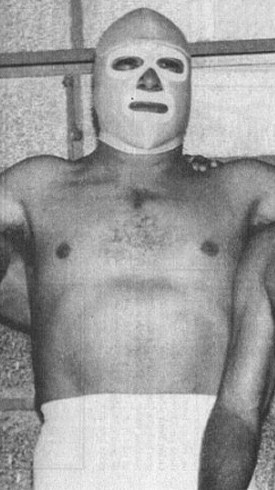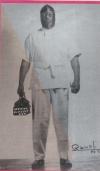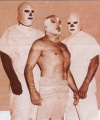Médico Asesino: Difference between revisions
Tinieblast (talk | contribs) |
No edit summary |
||
| Line 7: | Line 7: | ||
|nicknames=none | |nicknames=none | ||
|nameHistory=Don Cesáreo (debut - ??), La Bestia (1945), El Asesino, Médico Asesino (Mexico, 02/52 - death), El Médico (USA, 56 - death) | |nameHistory=Don Cesáreo (debut - ??), La Bestia (1945), El Asesino, Médico Asesino (Mexico, 02/52 - death), El Médico (USA, 56 - death) | ||
|family=[[Medico Asesino Jr.]] ( | |family=[[Medico Asesino Jr.]] (Son) | ||
|maestro=[[Verdugo]], [[Joe Marín]], [[Polo Torres]] | |maestro=[[Verdugo]], [[Joe Marín]], [[Polo Torres]] | ||
|birthdate=[[August 27]], [[1920]] - [[Chihuahua]], [[Chihuahua]] | |birthdate=[[August 27]], [[1920]] - [[Chihuahua]], [[Chihuahua]] | ||
Revision as of 22:38, 15 March 2009
Profile
| Médico Asesino (Assassin Medic) | |||||||||||||||||||||||||||||
 |
|
||||||||||||||||||||||||||||
Biography
When listing the all time great heavyweights in Mexico, the names that are quickly pointed out by most fans are Mil Máscaras, Canek and Dos Caras, and if we only count track record and not work quality, Cien Caras. But when coming up with any respectful list, in this select group we need to include Médico Asesino, the lost great heavyweight in Mexico.
Cesáreo Manríquez González, Medico's real name, was born on August 27, 1920 in Chihuahua, Chihuahua. Details with lucha libre birthdates are sketchy and several of the ones in this webpage are likely to be wrong, with the actual "real" magazines being at fault for some of the mistakes, but this one is 100% correct as it was taken off a copy of Medico's birth certificate.
At age five, Cesáreo moved to Torreón, Coahuila, where he studied first grade at the "Escuela Centenario". When he was a teen, he had his first job in the business, as he was the timekeeper at the old local Palacio de los Deportes where Giraldo del Hierro was the promoter. He then moved on to be a referee, and sometimes it provided for funny visuals because he was huge compared to all of the wrestlers. Del Hierro took notice of this and offered young Cesáreo, who had a day job as a bus driver, a spot in the roster as a full-time wrestler, as many times during his free time he hanged out with the wrestlers around the gym where he was being trained just for fun. The three luchadores that would be considered his maestros were Verdugo (the original one, not to be confused with Pirata Morgan's brother), Joe Marín and Polo Torres.
He wound up making his debut as "Don Cesáreo". He had the size but was not the most exciting of wrestlers, so to speak, as he wasn't a "natural" who learned fast. But he kept wrestling in several arenas around the country, until a year later he made it to Guadalajara where he wrestled for Elías Simón.
Historically, Simón (who ran shows at the Arena Oblatos and the Plaza de Toros El Progreso) is one of the local promoters of the old days that had a good eye for new talent. He saw that Cesáreo needed to spice up his act and gave him the name of "El Asesino", wearing black trunks, boots and mask.
Simón sent him to Monterrey to wrestle for Jesús "Chucho" Garza. He later wrestled as La Bestia (not to be confused with the wrestler with the same name at Arena Mexico in the mid 60s that lost his mask to Rayo de Jalisco) but on September 23, 1945 lost his mask against local idol and later international star Rito Romero at the Plaza de Toros El Progreso in Guadalajara, Jalisco. Unmasked, his status dropped and ended up going into retirement, working as a transporter. Things weren't actually going bad for him at all and he was financially secure, but he decided to give lucha libre another try, and asked his old boss Garza for a spot in the "carteleras" again.
With his natural size and ability, he was a diamond in the rough, but Garza still hadn't figured out how to make him a star until Televicentro (now Televisa) decided to show wrestling on TV. Garza booked Cesáreo for the first taping, who arrived to the studio/arena and didn't see his name in the line-ups. He went to ask Garza about it, but Garza told him not to worry while giving him a black suitcase, black mask and a white medic vest. Then he said "Now, you'll become El Médico Asesino".
Under that guise he made his debut on February 9, 1952 teaming with Wolf Ruvinskis to beat Enrique Llanes and Tonina Jackson... and he was an instant hit, thanks to his heel mannerisms and timing, his fierce attitude and his overall impressive wrestling ability.
Now, the first wrestling TV star in the history of lucha in Mexico was born! Just like in the early 90s non-fans would turn on their TV's to watch Octagon and Vampiro, from 1952 to 1955, every Saturday, turning on the TV at 8:30 PM to watch the luchas of Televicentro with El Médico Asesino, was like a ritual.
Also in 1952, Médico was the star of a movie called "El Enmascarado de Plata", written by José G. Cruz, directed by René Cardona and produced by Filmex. The movie originally was a vehicle for El Santo, whose comic strip had been published by Cruz during several months by that point. Santo rejected the offer and the role was given to the man the movie industry saw as the number two star in wrestling. After this movie, Médico also appeared in "El Luchador Fenómeno" and "La Bestia Magnifica" (in this one, as a wrestling action stuntman for Crox Alvarado). Even after his death, his image was still used on a couple other genre films.
Médico eventually changed his attire to his most famous all-white clothing, and dressed that way, formed vicious heel teams with Carnicero Butcher, El Espectro and El Bulldog. He also was the first wrestler in Mexico to ever have a woman with him at ringside, a pretty lady that went by the name "La Enfermera del Médico Asesino". This idea wasn't seen with good eyes by some, so she was somewhat "replaced" later with El Enfermero, a good brawler and technician of his era, who later became his most famous tag team partner as well as his best friend outside the ring.
During his Televicentro run, his major match was on Spring of 1952 against Gardenia Davis at Plaza México. The legend says that it featued an "impressive sold-out crowd". A record of the real crowd size will probably never be found, but chances are this may have been one of the biggest crowds ever in Mexican wrestling history.
The promotion ran by Chucho Garza, and funded by media mogul Emilio Azcárraga (owner of several TV and radio stations and newspapers, known as the Televicentro imperium) took a final hit when in 1955, Mexico City Mayor Ernesto P. Uruchurtu banned wrestling from TV due to it being a bad influence for the children.
But, unlike other "gimmick workers" or second rate stars whose career as headliners pretty much ended with Televicentro closing shop, Medico was enough of a hot commodity to be taken by the Lutteroths.
His style was unique in that he was around 190 cms, which is monster height for a Mexican (even more so back then), but he could work a technical bout on the mat. His strong point was his brawling, as he could use maneuvers like bodyslams or a swinging full nelson and make it look like he was toying with his opponent like he playing with a rag doll. His most famous finisher was the "castigo a las carótidas", a choke where he'd grab his opponent's neck with his enormous hands and apply pressure on the sides, to theoretically stop the blood influx to the brain from the carotids (the two main arteries on the neck).
Perhaps his most famous career match was on April 27, 1956, at the grand opening of the rebuilt Arena Mexico, when he teamed with El Santo to go over Rolando Vera and Blue Demon in an epic battle where he got over huge because, after defeating their opponents, Medico kept beating them up while the referes unsuccessfully tried to stop him. The semi-main event match that evening was El Enfermero versus El Gladiador.
On July 10, Medico joined forces with Enfermero and Santo, as the first "Ola Blanca" (White Wave) beating Polo Torres, Joe Grant and Blue Demon, also at Arena Mexico. Two days before, he'd headlined a sold-out Arena Coliseo defeating rival Joe Grant in a Super Libre match.
His popularity was such, that the Empresa relaunched the literally dead Heavyweight division, that hadn't largely meant much since the 30s when it was used as a promotional tool to push Charro Aguayo. Asesino beat Gran Lothario (José Lothario) in a tournament final on September 7 at Arena Mexico to capture the National Heavyweight championship that he'd never lose.
That same year he started wrestling in Texas, through the Garza connection, where he was simply known as El Medico. He was pushed quickly to the top as a foe for the local Latin star, Pepper Gomez, who he beat right away for the NWA Texas Heavyweight Title on October 19 in Houston. Medico's initial short stay lasted more than two years, with him holding the NWA Texas belt a grand total of five times, as well as the NWA Texas tag team titles two times with Pepper Gomez, as they had an in-ring friendship-hate relationship that went back and forth at least twice.
Other famous feuds he had in Texas were against Duke Keomuka and Johnny Valentine, whose hard-hitting style mixed well with Medico's rough style. Valentine and Medico, who was the tecnico here, often faced each other in the famous Houston City Auditorium in 2 out of 3 falls matches featuring plenty of blood. The popularity of this rivalry was such, that they headlined over local hero Pepper Gomez. Both wrestlers were protected in the feud, as then Valentine beat Medico on July 12, 1957, Medico had his foot on the ropes, and two weeks later (July 26), Valentine lost in the third fall after the match was ended via blood stoppage.
By this point, Medico was the highest positioned wrestler on the cards along with Gomez, Valentine and Don Leo Jonathan, and it was very extremely rare to see him lower than in the semi-main event. The city was in such fire, than they ran the bigger Houston Coliseum for bigger matches, which usually meant Lou Thesz coming to town to defend the NWA World Heavyweight Title against one of the top guns.
Medico got a total of four Heavyweight title shots against Thesz, the most famous one on August 9, 1957 at the Morris Sigel 41st Anniversary Show, where Thesz went over Medico in 3 falls via DQ. That show drew 11,000 fans and turned 5,000 away. To put things in contrast, when Jonathan challenged Thesz a month before, the house was of 9,200 fans. Medico's other recorded shots against Thesz were on December 14, 1956 in Houston, Feburary 28, 1957 in San Antonio and August 21, 1957 in Corpus Christi.
It's also interesting that around this time, El Medico got El Santo to work middle of the card matches at the Coliseum. Santo was well protected, even though he did jobs. On the other hand, Gory Guerrero was in the first or second matches usually losing to wrestlers without a name like Luigi Macera. Also of note is that on July 1, 1957, Guerrero lost against Medico cleanly in the third match from the top.
Being in Houston in 1958, he started feeling ill, and returned home. Back in Torreón he got examined, and during surgery in 1959 in Monterrey he got diagnosed with a very advanced cancer that his family always kept a secret from him. The strongman's looks quickly deteriorated, and Tonina Jackson (who was one of his best friends) and Jesús Garza convinced him to get a life insurance just in case something happened to him. Médico, not knowing how little time he had left, always refused, saying that he'd gain the weight back up and return to Houston where he would earn top money again.
On June 16, 1960, less than a year after the diagnosis, Medico died in his hometown, weighing less than 50 kilograms. He spent most of his latter months playing dominoes with his friends, such as Espanto II, Tonina Jackson, and even El Santo who also came to visit him. He saved the money he made in Texas and he wisely got life insurance, so his widow Socorro Silva and his five kids (ranging from 1-12 years of age) were able to build a new home and didn't suffer economically after his death. He was also very well liked by his peers, and the wrestler's syndicate held a major benefit show for him in Guadalajara. With the money collected, all of the kids were able to study and it's curious how the wife of Medico, after his death, worked as an "Enfermera" at a local hospital.
The news of his death made national headlines, equal to a policitian or movie star dying, and the following days, pictures of Polo Torres, Broadway Venus and Tonina Jackson crying made it to the lucha magazines. What made it unusual is that all three of them had lost hair matches against him and they were his worst enemies inside the ring, even though they were among his best friends in real life. El Enfermero was working at Arena Coliseo in Monterrey when Ciclón Veloz, the promoter, told him the news. Enfermero sat on the floor and started crying, ending a tale of friendship that would be written over and over again in the Box y Lucha magazine historical section decades after it actually happened.
None of Medico's son followed in his steps, and even though there has been (and there is) several wrestlers called Hijo del Médico Asesino and Médico Asesino Jr., they aren't "authorized" juniors.
On April of 1989, Médico was inducted at the Mexico City Box y Lucha Commission "Hall of Fame", but this hall has been largely been ignored and forgotten.
Luchas de apuestas record
| Date | Apuesta | Winner(s) | Loser(s) | Arena and/or Place |
|---|---|---|---|---|
| ??/??/?? | hair | Médico Asesino | Polo Torres | unknown |
| ??/??/?? | hair | Médico Asesino | Joe Grant | unknown |
| ??/??/?? | hair | Médico Asesino | Gonzálo Gómez | unknown |
| ??/??/?? | hair | Médico Asesino | José Indio Fermín | unknown |
| 45/09/23 | mask | Rito Romero | La Bestia | Monterrey, Nuevo León |
| 52/07/26 | hair | Médico Asesino | Tonina Jackson | Arena Coliseo - Mexico City |
| 54/08/?? | hair | Médico Asesino | Broadway Venus | unknown |


